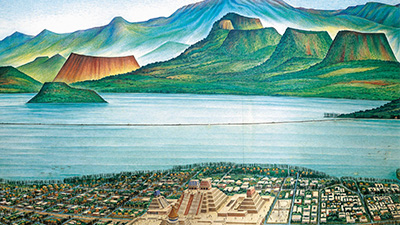Communities in the Americas
Driving Question: How were communities organized in the Americas?
During this period, the Americas were home to a vast array of different communities. From large empires to smaller kin groups, communities in the Americas were quite distinct from those in Afro-Eurasia. Yet these communities still shared surprising commonalities with their contemporaries in the Eastern Hemisphere.
Learning Objectives:
- Understand how Indigenous communities in the Americas were organized and how these communities interacted with each other.
- Understand the similarities and differences between societies that developed in the Americas.
- Use a graphic biography to support, extend, or challenge the overarching narratives from this period.
Vocab Terms:
- colonization
- conquistador
- epidemic
- indigenous
- migration
- oral tradition
- tribute
Opener: Communities in the Americas
To teach this lesson step, refer to page 2 of the Lesson 6.5 Teaching Guide.
Prompt parsing helps prepare students to write claims. Read more about our approaches to writing in the OER Project Writing Guide.
Ever been stumped by a question? Sometimes it’s less about not knowing the answer to the question than it is about understanding the question in the first place.
Indigenous American Communities
To teach this lesson step, refer to page 3 of the Lesson 6.5 Teaching Guide.
Review the Forum thread Ask Us Anything about bringing Indigenous voices into the classroom with Jerad Koepp and Natalie Martinez // 10-02-2023.
Communities in the Americas developed into a diverse tapestry of states, empires, chiefdoms, and tribal systems. Use the article and video below to explore how these societies emerged and evolved. Then, describe these communities from the perspective of an explorer.
-
Guiding Questions
-
Before you read
Preview the questions below, and then skim the article. Be sure to look at the section headings and any images.
While you read
Look for answers to these questions:
- What type of state was Haudenosaunee? How was it governed?
- What type of state was the Aztec state? How was its diverse population ruled?
- What evidence is there of connections between the Aztec and Mayapan societies?
- What kind of a state was the Inca state? How was it governed?
After you read
Respond to these questions: How do societies in the Americas seem distinct from those in other regions you’ve studied? Do you see any similarities?
-
Guiding Questions
-
Before you watch
Preview the questions below, and then review the transcript.
While you watch
Look for answers to these questions:
- How does the story of the Ancestral Pueblo challenge traditional world-historical narratives about agriculture and complex societies?
- How does Theresa Pasqual characterize Pueblo origin stories?
- Why are these origin stories important today?
- What are some strategies that Pueblo people used to thrive on the Colorado Plateau?
- How does Theresa Pasqual describe the movement of the Ancestral Pueblo people?
After you watch
Respond to these questions:
- What do you think are the differences between what we can learn from archaeology and what we can learn from oral traditions?
- What do you think historians should do when the two types of evidence disagree?
Key Ideas
Mesoamerica
To teach this lesson step, refer to page 5 of the Lesson 6.5 Teaching Guide.
Curious how well your students are comprehending Graphic Biographies? Use the Three-Step Reading for Graphic Biographies: Tool to help evaluate their understanding.
What do History Stories and Comics have to do with one another? Read more about it in this blog post.
The Aztec Empire was the most powerful state in Mesoamerica, but it took work to stay in power. Find out how conquests and tribute shaped the empire in this video and graphic biography.
-
Guiding Questions
-
Before you watch
Preview the questions below, and then review the transcript.
While you watch
Look for answers to these questions:
- What did Aztec society have in common with ancient Greece?
- What was the Triple Alliance, and in what context did it develop?
- How did the system of city-states help Hernán Cortés conquer the Aztec Empire?
- How did Aztec and Maya political communities differ from each other?
After you watch
Respond to this question: How does the Aztec state compare to different types of Afro-Eurasian states and communities you’ve learned about?
Key Ideas
-
Guiding Questions
-
Before you read
Preview the questions below, and then skim the comic, paying attention to things like prominent colors, shapes, and types of text and fonts. How do you know where to start and in which direction to read? What’s in the gutters (the space between panels)? Who or what is the focus of the comic?
While you read
- Who was Macuilxochitl and how does she describe herself?
- Macuilxochitl describes the Tenochtitlán (Aztec) conquest of Tlacotepec as “forays for flowers [and] butterflies.” What does this mean?
- Macuilxochitl writes that Axayacatl spared the Otomi warrior in part because he brought a piece of wood and deerskin to the ruler. What does this tell you?
- How does the artist use art and design to emphasize and demonstrate the importance of tribute?
After you read
Respond to this question: How does this biography of Macuilxochitl support, extend, or challenge what you have learned about the Aztec state and economy in this period?
Closer: Communities in the Americas
To teach this lesson step, refer to page 6 of the Lesson 6.5 Teaching Guide.
Illustrate what you’ve learned about communities in this lesson.
Empires in the Andes
To teach this lesson step, refer to page 7 of the Lesson 6.5 Teaching Guide.
Under the Inca’s mit’a system, tribute and mandatory service resulted in magnificent monuments, roads, bridges, and other infrastructure projects.
-
Guiding Questions
-
Before you watch
Preview the questions below, and then review the transcript.
While you watch
Look for answers to these questions:
- Who was Pachacuti?
- What did the Inca call themselves? What did Inca mean?
- What made the Inca an empire?
- How many people were living in the Inca Empire prior to its decline?
- What was the mit’a system?
After you watch
Respond to this question: What are the differences and similarities between the mit’a system of production and distribution and those of Afro-Eurasia during this era?






